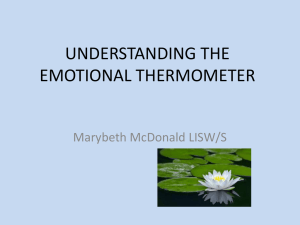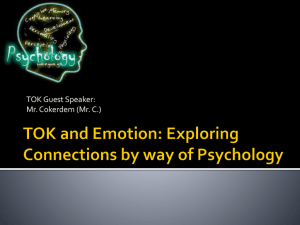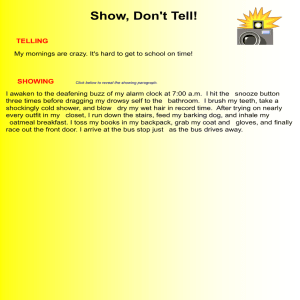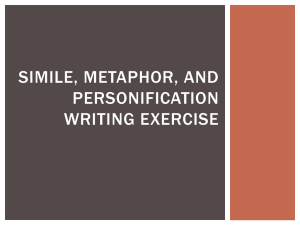Chapter 15: Neural Correlates of Conscious Emotional Experience
advertisement
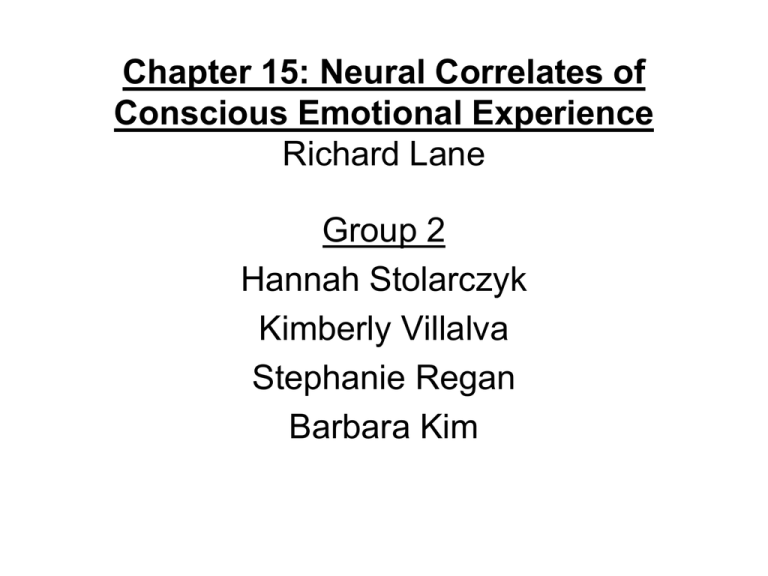
Chapter 15: Neural Correlates of Conscious Emotional Experience Richard Lane Group 2 Hannah Stolarczyk Kimberly Villalva Stephanie Regan Barbara Kim 1. What is the key assumption? Work on emotional awareness- language promotes and influences development of our perceptual blueprint (schemata) for processing emotional information – both external stimuli and internal, such as thoughts and memories How do “schemata” relate to linguistic descriptions of emotion discussed earlier in the chapter? • Established schemata's effect processing of emotional information (verbal & nonverbal) • The way we use language related to emotion affects our conscious experience of emotion • Example: Mothers describes emotional experience to children, “you feel sad” 2. How can schemata affect processing of nonverbal emotion information? • Schemata set up a situation that allows us to predict how others will respond, and allows us to respond. • Verbal and nonverbal emotion information lie along the same line. 2. How can schemata affect processing of nonverbal emotional information? • 70% of face-to-face communication is nonverbal. • One unconscious, nonverbal schema is that people smile when happy and frown when angry or unhappy. Thus, many people would think this man is angry. • We see a persons actions and interpret how we should before words are ever exchanged. • Reality – people didn’t smile during this era of photography because the exposure of the film took too long to hold a smile or relaxed pose. 4. Tell the class about the Levy Chimeric Faces Test (LCFT). • Uses 36 composite faces • One side neutral, one side smiling • Participants are asked which one is happier. • Determines which hemisphere is more dominant • Right hemisphere is more specialized for processing emotional 4. Contrast the LEAS, PAT, and LCFT • LCFT – Measures hemispheric dominance associated with processing of emotional information. • LEAS correlates strongly with PAT and with LCFT Supports that LEAS measures: - Complexity of emotional experience, doesn’t just measure verbal ability - Doesn’t measure intensity of affective experience - Used in processing emotional stimuli (verbal/nonverbal) - More emotionally aware people prefer right hemisphere which is specialized for detection of emotional cues 5. What knowledge about emotion was added when examining brain function with PET? • PET shows areas of increased • Recall-induced blood flow during tasks involved emotion cluster in BA film-induced emotional states 23 and recall-induced emotional • Film-induced emotion states. cluster in BA 24 • Overlap of the separate associations during film and recall- induced emotion between LEAS and blood flow of the ACC 6. Is the ACC near other emotion centers in the brain? The affective subdivision of ACC is connected to the amygdala, hypothalamus, hippocampus and orbitofrontal cortex, and has outflow to autonomic, visceromotor and endocrine systems 6.How does its role in emotion relate to other functions of ACC? • ACC has both cognitive and affective subdivisions. • ACC involved in the cognitive processing of emotion • ACC also involved in attention, pain, response selection, error detection, maternal behavior, vocalization, skeletomotor function, and autonomic control • It is not possible to entirely separate the processing of emotion from cognition or cognition from emotion. 7. How can emotion guide attention? Do people pay attention to things that make them feel emotion? Or to the emotion itself? Is attention focus guided by anything other than emotion? • Emotion, pain, or other external or internal stimuli provide moment-to-moment guidance to the ACC about how to allocate attention. • People attend both to the stimuli and the emotion in a complex top-down/bottom up interaction • Attention focus is often guided by salience: prominent stimuli will grab attention. Dangerous stimuli are more salient than neutral/mildly pleasant 7. How can emotion guide attention? Do people pay attention to things that make them feel emotion? Or to the emotion itself? Is attention focus guided by anything other than emotion? • The conscious experience of emotion could occur concomitantly and automatically as attention gets redirected by emotion. The role of the ACC in the conscious experience of emotion fits well with its other functions, (ie: pain or maternal behavior) suggesting that this role is not exclusive to emotion. • People who are more emotionally aware, attend more to internal and external emotional cues, so the cognitive processing of this information can contribute to ongoing emotional development. • Attention guided by salient stimulus of dog. 8. The Stroop task was the first task noted to really activate the ACC. What is the relationship between this finding and discussion about ACC and emotion and attention in the chapter? • Stroop task measures capacity to direct attention • Stroop is a cognitive task, but it activates the ACC. • Stroop task supports theory that ACC processing mechanisms underlie selective attention. • Stroop task requires you to say the color of the word, not what the word says.


